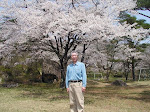Happy New Year
2025
The Year of the Snake
2025 is “the Year of the Snake”, which is called Mi-Doshi(巳年)in
Japan. The character for Mi(巳)is a pictograph
that represents the shape of a fetus, and is said to have originated from the
appearance of a uterus enveloping a fetus.
When “Mi” is applied to animals, it becomes “Snake”,
and there are two reasons for this.
Since ancient times, snakes have been the subject of
faith and have been worshipped as valley gods (who govern valleys and lowlands)
and fertility gods. The reason why Mi(巳)is used in the Matsuri(祀り, “sacred
part of rituals and rites”)is because Matsuri(祀り)refers
to the worship of nature gods, and because the most representative deity of
nature gods is the Snake.
In addition, snakes
are also associated with “rebirth” because they shed their skin, and because
they can live a long time without eating, they are worshiped as “messengers of
the gods,” and there are shrines throughout Japan that enshrine the snake god.
For example, Benzaiten(弁財天), one
of the Seven Lucky Gods(七福神, Shichifukujin in Japanese)is the
goddess of wealth and performing arts, and her messenger and incarnation is
said to be a snake.
Last of all, as a snake awakens from hibernation and
crawls out onto the ground, it signifies the budding of plants that took root
in the winter and “the birth of new seeds.” This is why the year of the snake
is considered to be “the year that marks the beginning of a new era.”
Haiku for the
Snake
The snake seemed
to have appeared to view the azaleas in full bloom in the early summer sunshine
and to celebrate the Kai-no-Sawa Azalea Festival.
躑躅祭蛇も開園祝いけり
tsutsuji-sai hebi mo kaien
iwai keri
The snake
celebrating azalea
festival
in full bloom
貝の沢司る蛇目の前に
kai-no-sawa tsukasadoru kami me no mae ni
The snake
governing
Kai-no-sawa
in front of me
Kai-no-Sawa(貝の沢)is a
valley with a lowland that is governed by a snake, the god of the valley, and I
was lucky and surprised to encounter the snake while walking through the
valley.
Additionally, Kai-no-Sawa is an interesting
geological site, with large rocks dotted high in the valley containing relics
resembling shell fossils.
The place name Kai-no-Sawa
uses the word "shell" (貝, Kai in
Japanese) in reference to these shell fossils.
At the beginning of the year, I wrote two haiku to
celebrate the new year. In addition, tomorrow I will briefly introduce a
rebirth story related to Kai-no- Sawa to celebrate the new year.
秋田国際俳句ネットワーク
蛭田 秀法
HIRUTA Hidenori
Akita International Haiku Network
https://akitahaiku.com/2025/01/01/

.png)
.JPG)

0 件のコメント:
コメントを投稿